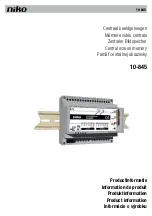
USER GUIDE
SVGA DLP PROJECTOR
12
6 MAKING THE CONNECTIONS
The projector may be connected in various ways to different equipment.
The following sections describe in detail how to connect to these systems.
See the illustration on the rear of the quick set-up card on how the various
system parts connect together.
Be aware of static electricity that may build up in the dry season and when
operating on synthetic carpets. Discharge any static electricity by touching
a metallic surface before you start.
Place the projector on a table at a suitable distance to the projection
screen. Select a screen with good reflectivity and avoid direct sunlight
shining in. Place the projector so that the image is visible to the whole
audience, and so that the unit does not obstruct the view. The projector is
supplied with long cables for high flexibility in placement.
Various cables are supplied or optionally available to connect to different
sources. Follow the list below in numerical order for a trouble-free set-up!
1.
SWITCH OFF
. Switch off all equipment before making all the
connections.
2.
COMPUTER GRAPHICS ADAPTER.
Computer graphics adapters use
different connectors depending on the actual computer system in use.
Connection to the projector is made through a basic SVGA cable and
appropriate adapters.
•
PC
. Use the SVGA cable directly to connect the graphics port
of the PC to the COMPUTER connector on the projector. If
needed, connect your monitor cable to the free branch on the
SVGA cable.
•
MAC
. Use the MAC adapters, as marked, on the computer end
of the SVGA cable to adapt to the graphics-port connector and
monitor connector on the MAC.
•
NEC
. Use the optional NEC adapters, as marked, on the
computer end of the SVGA cable to adapt to the graphics-port
connector and monitor connector on the NEC.













































